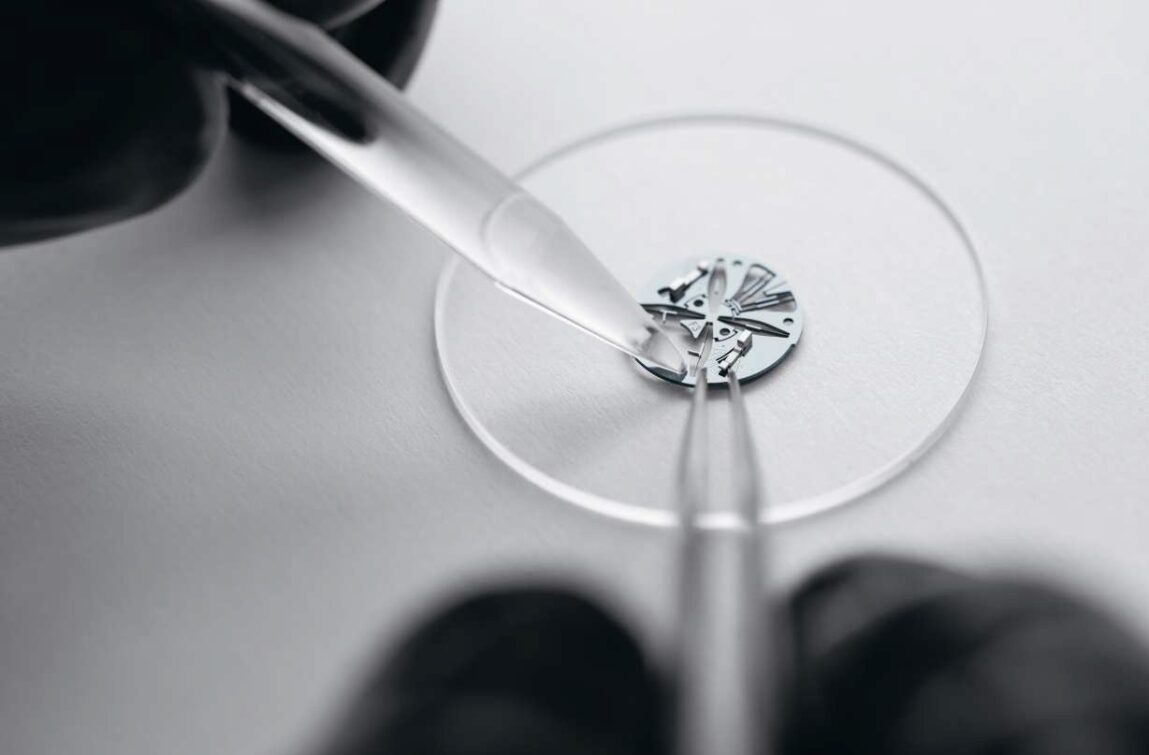Text Max Montre
The element silicon, indispensable in the manufacture of high-tech components in the computer industry, has also conquered the world of watches in the last twenty years or so. The semi-metal has opened up unimagined possibilities that have taken the mechanical watch to a whole new level and shaken up centuries-old principles.
They were clearly ahead of their time and at the same time heralded a new era: Rolf Schnyder, then owner of the watch brand Ulysse Nardin, and the watchmaker Ludwig Oechslin. In 2001, the ingenious team presented a wild creation in the midst of a conservative watch world full of conventions, one that managed without a dial, hands or crown. It was clear to Schnyder that there was only one name for this creation: Freak. Because the timepiece stood out from the crowd of watches due to its visual and technical characteristics (and still does today)—an iconoclastic act of watchmaking audacity. Its design stems from the idea of a timepiece that is also a kinetic sculpture whose main purpose is to convey an emotional, artistic expression of time. 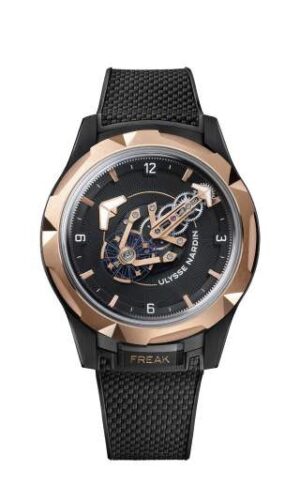
The Freak went its own way in terms of design: you won’t find conventional hands, dial or crown here.
The watch, whose design seemed to be straight out of a science fiction movie, was groundbreaking in two respects. Firstly, the Freak was the first watch ever in which the movement rotates to indicate the time. The mainspring barrel, the tank of the watch in which the powerful mainspring is located, turns once every twelve hours. It is connected to a central gear wheel that drives the bridge with the gear train around the circumference of the dial at one revolution per hour—the so-called flying one-hour carousel. The focus was on the completely new escapement invented by Ludwig Oechslin, a double-wheel movement with direct drive, which, like the balance spring and the balance wheel, is attached to the end of the bridge. The system pulsates before the viewer’s eyes like a beating heart.
ANOTHER WORLD PREMIERE
When you look at this heart, you notice that it shimmers blue-violet. Which leads to the second groundbreaking point: For the first time, a material was used that had previously played no role in watchmaking and was known to a wider public at best from computer chip production—silicon. Two pin-sized wheels of the new escapement were made of this material. Rolf Schnyder, who died in 2011, commented: »I needed something that would allow me to outperform the competition and take a leading role in the new technology. When I saw silicon and realized its true potential for watchmaking, I knew that this was our chance.«
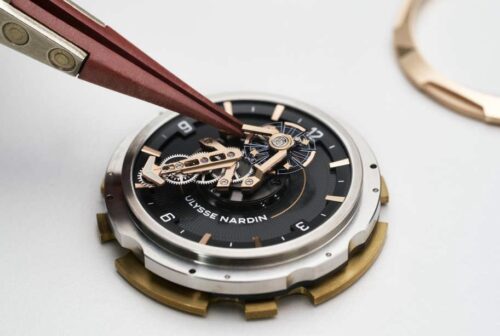
The Freak’s work also serves to indicate the time.
What potential are we talking about? As an element of the carbon group, abbreviation Si, atomic number 14, the material is strong yet flexible, light, rust-free, highly durable and resistant to temperature fluctuations, which have a strong influence on the accuracy of the watch. In addition, silicon parts do not require lubrication in order to function smoothly. It is therefore an ideal material, especially when it comes to the modern godsend of watchmaking: magnetism. After all, it is responsible for more than 90 percent of service problems today. If a conventional mechanical watch is exposed to a magnetic source, this changes the rhythm of the movement, the watch goes wrong and has to go to the workshop.
MAKE IT BEAT
Experts and competitors initially reacted rather cautiously to this material innovation. It was only when Ulysse Nardin launched the first silicon balance spring shortly afterwards that things started to move. Major players such as Rolex, Patek Philippe and the Swatch Group quickly set about catching up. But more on that later.
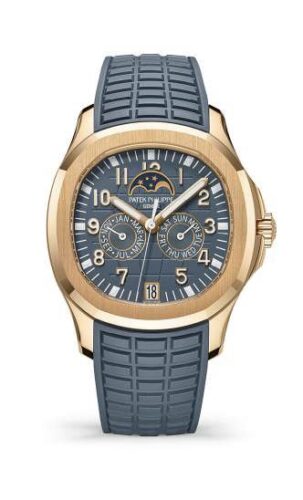
Patek Philippe, Aquanaut Luce Annual Calendar Reference 5261R-001, 2023
First of all, why is so much fuss being made about this tiny component weighing just a few grams? Well, it is the balance spring that makes the heart of the watch beat. It is probably no coincidence that a giant stylized balance spring towers over the entrance to the Patek Philippe headquarters in Geneva. It is the most important part when it comes to improving the precision of mechanical timekeeping. Coiled in a spiral and significantly thinner than a human hair, it is connected to the balance wheel, contracts and expands again. The uniformity of this oscillation, also known as the frequency, ultimately ensures the accuracy of the watch.
INGENIOUS SYSTEM
Its history goes back a long way. At that time, the Dutch physicist Christiaan Huygens was working on optimizing the balance-spring system and discovered that it was only possible to keep a steady beat on the timepiece with the help of a flexible spiral spring. This is because it manages to slow down the oscillation of the balance wheel by pulling it back and allowing it to swing out in the opposite direction. It is an ingenious system that the scholar developed, one whose basic principle can still be found in almost every mechanical movement today.
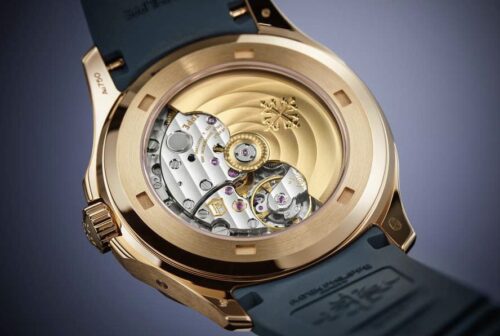
The Aquanaut Luce annual calendar reference 5261R-001 from Patek Philippe is equipped with a new automatic caliber whose balance spring is made of »Spiromax«. The material of choice is silicon.
Since then, many great watchmakers have contributed to the improvement of this essential component. The most famous is Abraham Louis Breguet. In 1796, he succeeded in increasing the precision of the hairspring by bending the outermost winding. The term »Breguet hairspring« can still be found today in many of the relevant technical instruction leaflets for modern watches. A few decades after Breguet, the French mathematician Eduard Philips succeeded in calculating the perfect bend of the hairspring.
PERFECT MATERIAL
The spiral itself performs hard work. It performs several hundred million oscillations a year. That takes its toll. The part is susceptible to wear and sensitive to temperature and magnetism. Despite these various external influences – vibrations and fluctuations in air pressure should also be mentioned—the oscillations of the balance wheel and balance spring should be as uniform as possible, or »isochronous«.
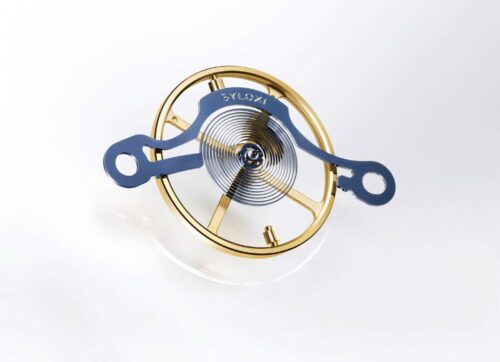
Rolex 1908: »Syloxi«-silicon balance spring
To ensure this, the perfect material was also considered early on. Various metal alloys are usually used today—above all the market-dominating »Nivarox« from Nivarox-FAR, part of the Swatch Group, which has provided the necessary precision and reliability since the 1930s. Albeit with some compromises.
SMOOTHLY BETTER
In principle, the story could have ended here, had it not been for the fact that 70 years after the invention of Nivarox, a small luxury watch manufacturer came around the corner with silicon, heralding a new era in mechanical watchmaking and scaring off the competition. And so the watch giants Rolex, Patek Philippe and the Swatch Group joined forces with the Centre Suisse d’Electronique et de Microtechnique (CSEM) in Neuchâtel in an unusual alliance to develop a production process for silicon hairsprings. The microtechnologists even managed to solve a problem that even the semi-metal silicon is not immune to—temperature sensitivity. A circumstance that does not necessarily have a positive effect on the filigree structure of a spiral spring. The solution was found in the form of a thin layer of silicon oxide, which ultimately led to a significantly higher temperature resistance of the component.
Patek Philippe forged ahead and in 2006 presented its first functioning series watch with a balance spring made of monocrystalline silicon, the Reference 5350, called »Spiromax«. The manufacture launched the first escape wheel made of Silinvar, a silicon derivative, back in 2005, followed by the »Spiromax« hairspring (2006), the »Pulsomax« escapement (2008), the »Oscillomax« regulating assembly (2011) and a further optimized version of the »Spiromax« hairspring (2017). The company has remained true to the element ever since. For example, the Aquanaut Luce annual calendar reference 5261R-001, the first annual calendar in the Aquanaut collection presented at the 2023 edition of Watches & Wonders, features a new automatic caliber with a balance spring made from »Spiromax«.
1908 – 2023
Rolex also found a catchy name for the researched material, »Syloxi«. Its temperature-compensating and paramagnetic properties are used in the Syloxi hairspring. In addition, Rolex has optimized the isochronism of the hairspring and the regularity of the oscillator vibrations by means of a patented geometry developed in-house. The syloxis hairspring is manufactured entirely in-house at Rolex using a high-precision manufacturing process known as deep reactive ion etching (DRIE), which etches the components out of the silicon wafer. A process that is not only used at Rolex. The Syloxis hairspring was introduced in 2014 with the caliber 2236, the first of a new generation of Rolex movements. This caliber has a paramagnetic escapement wheel in a nickel-phosphorus alloy, which improves its resistance to magnetic fields, and an in-house developed mainspring that allows the power reserve to be increased to around 55 hours and ensures a more constant power supply to the movement.
LITTLE MIRACLE
For the quite new 1908 line, Rolex engineers developed the Calibre 7140, a completely new movement with automatic winding, two hands in the center and small seconds at the 6 o’clock position. Five patent applications were filed for this slim movement, which was developed and manufactured entirely by Rolex. Thanks to the Syloxi hairspring, the Chronergy escapement and the Paraflex anti-shock system, it has a power reserve of approximately 66 hours. It goes without saying that, as is usual with Rolex, this is an extremely precise chronometer of superlatives. The 1908, named after the year in which the brand name was officially registered in Switzerland by founder Hans Wilsdorf, does not necessarily jump out at you. With the numerals 3, 9, 12 and the small seconds at the 6 o’clock position, the 1908 reinterprets the style of the Oyster Perpetual from 1931 and gives it a modern touch. Its design is classically understated.
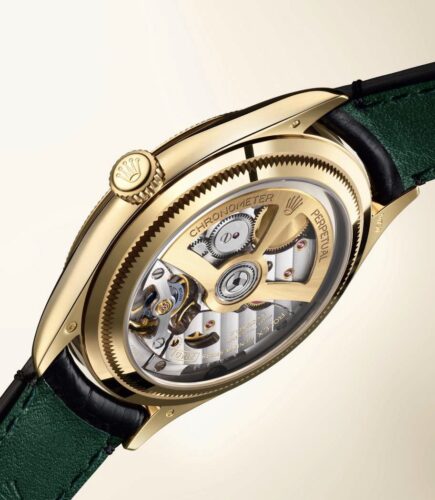
A completely new line: The 1908 is the first Rolex watch to feature a transparent case back that reveals the movement. This allows you to admire the beauty of the finishing of the movement – and the breathing of the »Syloxi« silicon balance spring.
If you turn the ticker over, however, you will experience a small miracle: Rolex has given the 1908 a transparent sapphire crystal case back, which is very unusual, as the movements are usually well screwed down and hidden behind a cover. But this allows you to admire the beauty of the movement’s finishes—and the breathing of the silicon balance spring.
COMPETITION LEFT BEHIND
The third in the group is still missing: Omega. The Co-Axial escapement, invented by British watchmaker George Daniels and developed by Omega, solved the age-old problem of friction, which can affect long-term accuracy, back in 1999. This special escapement reduces contact surfaces and requires less lubrication. In 2008, the Si14 hairspring for the Co-Axial escapement came into play—with all its positive properties. Further development steps followed until the Spirate system was introduced this year, a new, patent-pending silicon balance spring that enables ultra-fine rate regulation. With this innovative mechanism, Omega can now fulfill an extraordinary promise: certified precision of 0/+2 seconds per day. This puts it ahead of the competition.
THE END?
The Spirate system, part of the Co-Axial Master Chronometer Caliber 9920, can be found in the new Speedmaster Super Racing. The model is a nod to the Omega Seamaster Aqua Terra from 2013, which impressed with its magnetic resistance of up to 15,000 gauss. In any case, it is also thanks to the market power of the Swatch Group that ordinary earners can also enjoy the benefits of silicon. Components can also be found in watches from Tissot and Mido, among others, brands that are priced in the »entry-level segment«.

Speedmaster Super Racing from Omega: its system, christened »Spirate«, revolves around a new, patent-pending silicon balance spring that enables ultra-fine rate regulation.
If you ask whether the end of the line has finally been reached in this area, the answer is no. In recent years, two brands have shown that it is possible to go one step further with silicon. So far that purists fear that the creations may no longer have anything to do with classic mechanical watches. Silicon components had already been accepted somehow, but the fact that someone could dare to question the system »balance wheel with balance spring and anchor plus escape wheel«—we are thinking of Huygens—as such, made some people gulp.
RESEARCH & DEVELOPMENT
Take Guy Sémon, for example. The natural scientist approached the subject from a completely new direction and in a completely different way than watchmakers would have done. Sémon quickly realized that simply optimizing the existing basic principle according to Huygens could not be the solution. The technical possibilities of Huygens’ principle had simply been exhausted. He therefore consistently questioned it and found completely new ways to build watches using modern technologies and new materials. Via the research department at TAG Heuer, where he made a name for himself, his path led him to the LVMH Watch Division, where he became CEO of the research institute and presented Zenith’s Defy Lab in September 2017. Like TAG Heuer, the brand is part of the world’s largest luxury group. The Defy Lab’s innovative rate regulator consists of a single piece of monocrystalline silicon (with parts thinner than a human hair) and replaces the balance wheel, balance spring and anchor in one go.
PERFORMANCE
The Defy Lab replaces the more than 30 individual parts of the usual regulating organ of a mechanical watch with a single component that is only half a millimeter high. By comparison, the height of a conventional regulating organ is around five millimeters. Mechanical connections between different components are simply eliminated, which completely removes adverse effects such as friction, wear and play between the components, the need for lubrication and complex assembly. The escape wheel is also made of silicon. The new escapement wheel oscillates at a very high frequency of 15 Hertz. The new caliber, called ZO 342, apparently achieves a rate accuracy that has never been seen before in a mechanical watch. Magnetic fields and temperature fluctuations should no longer affect performance.
The second hand of the Defy Lab moves across the dial without jerking, and no ticking can be heard. The equally moderate movement of the balance wheel can no longer be seen; instead, it looks as if the watch as a whole is vibrating. The rate regulator oscillates at a very high frequency of 15 Hertz. That is 108,000 vibrations per hour. If you follow the rule of thumb »the faster, the more precise«, then this is very impressive. One year later, Zenith launched the Defy Inventor with 18 Hertz, an even faster, more precise watch. Since then, however, it has been rather quiet on the subject.
A MONOLITH
Until Frederique Constant came around the corner with a new development in 2021. The Geneva-based manufacturer, part of the Citizen Group since 2016, presented the Slimline Monolithic Manufacture. An ordinary watch at first glance, its special feature shimmers in the typical blue of silicon. The part is a new type of regulating organ. With the help of specialists in Delft, the Netherlands, Frederique Constant also succeeded in incorporating a silicon oscillator from a single casting, hence the name »monolithic«, into the watch. But unlike its competitor from Le Locle, whose diameter takes up a relatively large amount of space in the movement, the Geneva-based oscillator is so small that it can be implemented in an automatic movement instead of the classic escapement. Its diameter is only 9.8 millimetres with a height of 0.3 millimetres.

Frederique Constant presented 2016 the Slimline Monolithic Manufacture. A new type of regulating organ can be seen at 6 o’clock.
The key figures of the escapement, which took two years of research, are impressive: the heart of the Monolithic Manufacture oscillates at a frequency of 40 hertz, i.e. 288,000 vibrations per hour. Not bad, but it brought with it a problem: a traditional gear train is not capable of handling the speed of a 40 Hertz regulator. So a new movement was needed, which was named the FC-810 caliber. High-speed cameras capable of recording 250,000 images per second had to be used to measure the rate accuracy. The bottom line is that Frederique Constant is consistently pursuing the path taken by Zenith—and others before it. Apparently with success: the Monolithic models are currently sold out.
The question arises as to what else the Swiss inventors are doing to push the boundaries of what is physically possible. And which element will perhaps one day take over from silicon.
ARTICLE FIRST PUBLISHED IN CHAPTER №VIII »ELEMENTS« — SUMMER 2023

